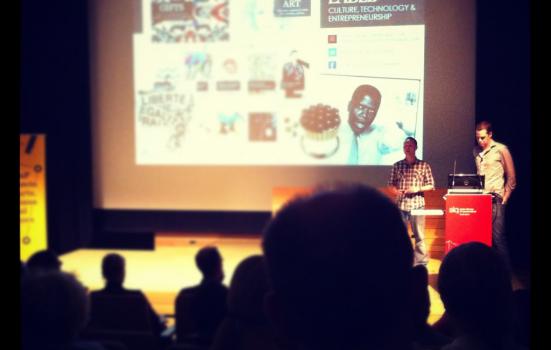Peter Tullin is optimistic that there is a huge demand for a form of cultural entrepreneurship where people and experiences that were formerly unconnected are brought together.

Much has happened in the three years since I published‘Intelligent naivety’ (co-written with Simon Cronshaw). The economic downturn in Europe and the US shows no sign of coming to an end, but the growing economies of Asia and elsewhere are beginning to rival and supplant the West. Technology continues to be a major driver of both economic and cultural change, significantly affecting how we consume cultural content. My research piece for Nesta, which forms the core of my new book ‘REMIX’, examines the intersection of culture, technology and entrepreneurship. It is in this dynamic space that we in the cultural sector will find ways to revolutionise our business models.
Entrepreneurs, whether inside or outside organisations, strive to change the world. The spread of their ideas, products and platforms, which has been facilitated and speeded up by the digital revolution, will continue to challenge accepted wisdom and disrupt established ways of doing things. Change is the new constant. One important change is that the balance of power between brands (cultural or otherwise) and consumers has shifted. In our connected world the user, customer, audience or bystander can innovate, even when organisations themselves do not (or will not).
One characteristic shared by these examples of cultural entrepreneurship is the way they bring together people and experiences that were formerly unconnected
The research forthe book examined consumer and technology trends, new ideasand organisations that are reshaping the landscape and ushering in an age of opportunity for the cultural entrepreneur. The findings confirmed that there is an insatiable demand for what the cultural sector is well placed to supply, and that entrepreneurial strategies are emerging to exploit these new market opportunities.
CultureLabel.com provides one example of cultural entrepreneurship in action. The company has grown each year since we launched the concept, and as a result of our successwe have received significant technology venture capital funding so that we can internationalise the website. This new investment will benefit our arts and museum partners as well as the artists, makers and designers with whom we work. Inspiring cultural entrepreneurs are operating investable private-sector models across a diverse range of artforms. Here are some examples:
- Retronaut.com, set up byarchivist Chris Wild, has a following of hundreds of thousands of users, Twitter followers and Facebook fans who tune in daily to his curated ‘time capsules’ of archival images.
- DigitalTheatre.com has created a Netflix for theatre and recently launched an App for the Samsung Smart TV, having secured investment from Ingenious Media.
- The phenomenal success of Secret Cinema in turning film into a live interactive experience is challenging the dominance of the multiplex, and its showing of Prometheus attracted even more attendees than at the BFI Imax. Secret Cinema (and its newly interwoven brands Secret Restaurant and Secret Hotel) feed back entrepreneurial income into the artform by promoting independent short films through ‘Future shorts’.
These cultural entrepreneurs are creating ‘passion brands’ that are tapping into the emotions of a growing number of consumers who are looking for a richer and more authentic experience than that provided by chain stores and the highstreet.
One characteristic shared by these examples of cultural entrepreneurship is the way they bring together people and experiences that were formerly unconnected. If we project these micro-experiences onto the larger economy, what could ‘remixing’ mean for UK plc? One place to look is Austin, Texas, where the South by South West Festival (SXSW) has some interesting lessons for London’s Silicon Roundabout (or Tech City as it is also known), as well as for the many hubs nationwide tasked with developing technology or enterprise.
South by South West is a festival of global creativity. Its particular claim to fame lies in having hosted the breakthrough moments of start-ups like Facebook and Foursquare, and many entrepreneurs and investors have headed to Austin in the hope of emulating their success. Held annually, South by South West is a melting pot of ideas, attracting over 100,000 delegates from the worlds of music, film and interactive media. A lot of the magic happens where these creative disciplines intersect: innovation occurs where difference meets.
The challenge therefore is to create opportunities for worlds to collide. We ‘do’ arts and culture really well in London and the UK, with iconic global brands like the Tate, the Serpentineand the V&A. We have content holders such as the BFI, and content creators like the RSC and National Theatre. Blurring the boundaries between technology and creative disciplines needs to be in the DNA of Tech City and similar initiatives if they are to thrive. They should become bastions of an ‘everyday SXSW’, capitalising on London’s position as one of the true global cities with a rich and varied culture and a diverse population.
The creative and cultural industries are wealth creators in their own right and overall have continued to grow despite the recession. Recent research predicted that the East London creative economy could overtake the City within five years. Survey upon survey highlights the UK’s cultural scene as one of the biggest reasons why so many people want to live here. Technology and enterprise policy initiatives need to have culture hardwired into them if we want to attract and retain talent and provide a fertile creative undercurrent to the everyday life of the city.
Austin is only one example of the success of the culture/technology/enterprise formula. Toronto is another case in point, emerging as a tech location partly because companies like Ubisoft want to work with the burgeoning Canadian film industry in order to make their games more realistic.
Channel 4’s film production arm Film4, which is behind recent films as diverse as The Iron Lady, Shame and Attack the Block, provides proof of the value of blurring creative disciplines. The recently announced Film4.0, an innovation hub, is developing cinematic work across multiple digital platforms and artforms. Anna Higgs, a Clore Fellow who heads up Film4.0, is working with a number of companies in the Silicon Roundabout area, including social-gaming company Hide&Seek. In her words: “The boundaries between platforms are falling away as audiences are able to access stories in myriad ways. Therefore it’s vital that we work across creative disciplines and develop new forms of author-led collaborations that blur the lines between fiction and reality, film and games, and much much more. Right across the UK, it’s brilliant to see hubs of creative practitioners forming, enabling this kind of innovative work.”
This is happening in places like Bristol, where Watershed and other organisations have made partnership development and a cross-disciplinary approach the starting point for their pioneering work, though finding the necessary capital and investment to realise the growth potential of their projects remains a problem.
Top of the list of challenges for the year ahead are these questions: how do we create the opportunities and spaces for the best creative minds to mix with the best tech and entrepreneurial minds? How do we nurture the entrepreneurial seeds that emerge?
Peter Tullin is a Director of CultureLabel.com.
Clore Leadership programme
In 2009 Peter Tullin, together with Simon Cronshaw, wrote ‘Intelligent naivety’, a handbook for aspiring cultural entrepreneurs, which analysed untapped cultural assets and offered a methodology to generate new income streams and new audiences.
Peter and Simon had just embarked on their own entrepreneurship journey by setting up CultureLabel.com, an e-commerce website which aggregates art with products from cultural institutions. They had really caught the bug and felt it was for individual organisations to choose whether or not they wanted to monetise aspects of their relationship with the user in order to generate a commercial and cultural dividend. But if they did, then the most important thing was to look at themselves through the varied lenses of the consumer.
As the recession bit hard, thousands of copies of the handbook weredownloaded and Peter and Simon were asked to speak about cultural entrepreneurship in far-flung locations.The offer of a Nesta Fellowship on the Clore Leadership programme gave Peter the opportunity to reflect on his experience, andwith support from theArts and Humanities Research Council and John Holden at City University, to undertake research for a follow-up piece.




